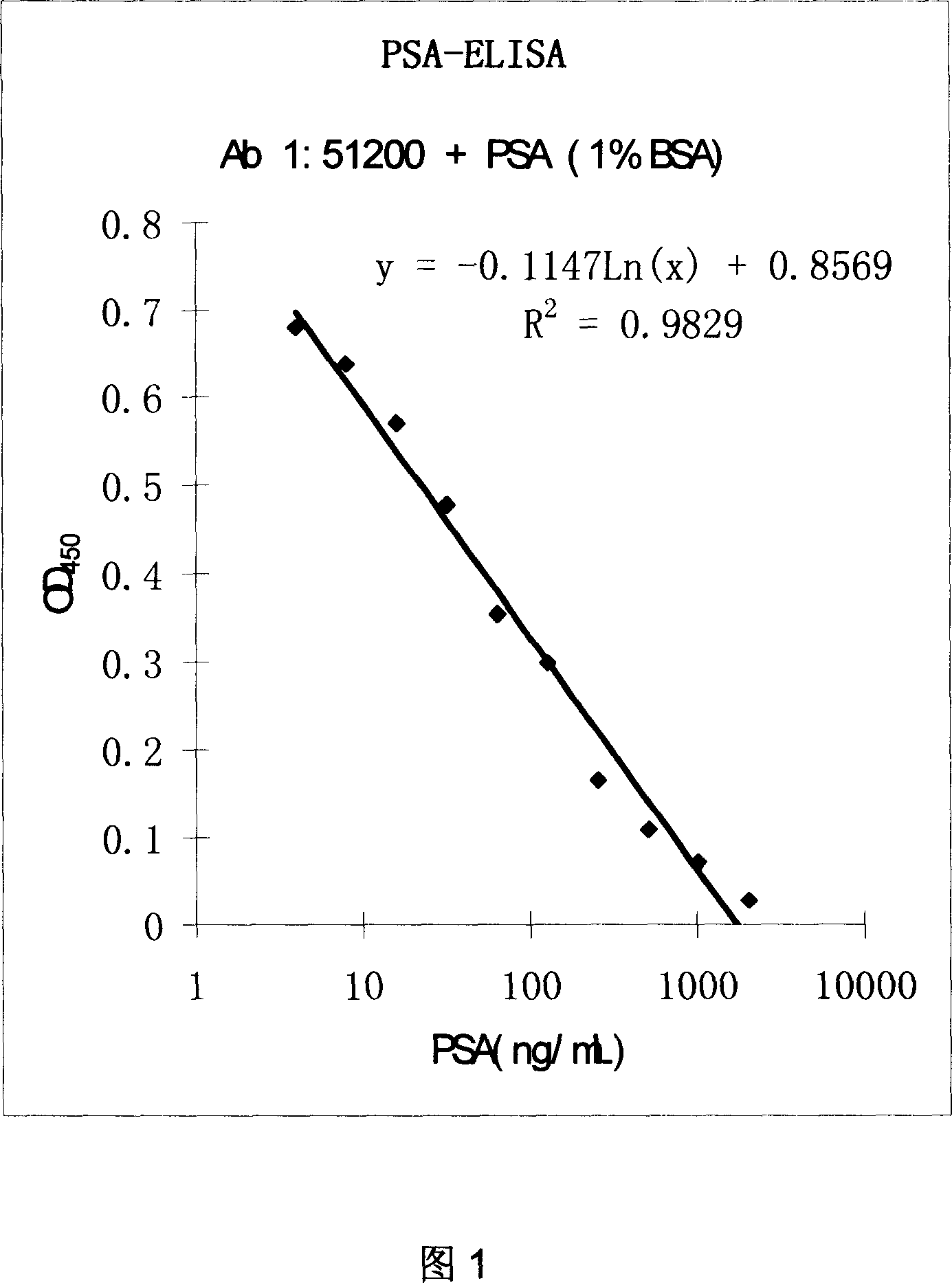Anti-prostate-specific-antigen PSA monoclone antibody and its use
A monoclonal antibody and prostate-specific technology, applied in anti-animal/human immunoglobulin, instruments, measuring devices, etc., can solve the problems of high price, insufficient sensitivity of PSA detection, unsuitable for large-scale clinical application, etc., and achieve good results The effect of antibody characteristics and sensitive detection range
- Summary
- Abstract
- Description
- Claims
- Application Information
AI Technical Summary
Problems solved by technology
Method used
Image
Examples
Embodiment 1
[0054] animal immunity
[0055] BALB / c healthy mice homologous to the used myeloma cells were selected, and the age of the mice was 8-12 weeks, male or female. Antigen was human free PSA (Biocheck, INC. CAT#4001). Antigen stock solution concentration: 1.84mg / mL, Balb / c mouse immunization dose: 100μg PSA each time. The injection method is multi-point intramuscular injection. Dilute with PBS or normal saline before use. Immunization program: 0, 3, 6 three times immunization. Three days before the fusion, take 100μg and dilute it with PBS to 0.5mL for intraperitoneal injection for memory stimulation. Three days after the last immunization, splenocytes were isolated for fusion.
[0056] Antibody titers in mouse serum after table 1 is immunized with PSA for the third time
[0057] Detection of antibody titer in mouse serum by ELISA after the third immunization with PSA
Embodiment 2
[0059] Construction of hybridoma cell lines and preparation of monoclonal antibodies
[0060] 1. Culture of myeloma cell lines
[0061] The most important point in selecting a tumor cell line is homology with the B cells to be fused. If spleen cells are to be fused, various myeloma cell lines can be used, and we use SP2 / 0 cell line. The cell line has good growth and fusion efficiency. In addition, the cell line itself does not secrete any immunoglobulin heavy chain or light chain. The highest growth scale for cells is 9×10 5 / mL, the doubling time is usually 10-15h. Fusion cells are selected in the logarithmic growth phase, with good cell shape and activity (activity greater than 95%). Myeloma cell lines should be adapted to culture medium containing 8-azaguanine before fusion, and the cell concentration should be adjusted to 2×10 with fresh medium the day before cell fusion. 5 / mL, the next day is generally the logarithmic growth phase cells.
[0062] 2. Preparation of f...
Embodiment 3
[0089] Applications of Monoclonal Antibodies
[0090] 1. Antigen coating amount saturation curve
[0091] Use the cell supernatant (dilution one time) as the detection sample, the amount of coated antigen varies from 0.125 to 4g / mL, the primary antibody is the cell supernatant of each clone, and the dilution is one time, and the secondary antibody is detected with goat anti-mouse-HRP . It can be seen from the slope of the curve that when the antigen is coated at 2 μg / mL, the antibody in the supernatant begins to be excessive. In the range from 0.125 μg / mL to 1 μg / mL, the slope of the curve is relatively high, indicating that the antigen coating is more sensitive in this range, so we choose the subsequent antigen coating concentration to be 0.5 μg / mL.
[0092] The curve of PSA coating concentration exploration is shown in Fig. 3 .
[0093] 2. Antibody competition ELISA experiment to determine whether the five cell lines are determined by an antigenic determinant. One times ...
PUM
 Login to View More
Login to View More Abstract
Description
Claims
Application Information
 Login to View More
Login to View More - R&D
- Intellectual Property
- Life Sciences
- Materials
- Tech Scout
- Unparalleled Data Quality
- Higher Quality Content
- 60% Fewer Hallucinations
Browse by: Latest US Patents, China's latest patents, Technical Efficacy Thesaurus, Application Domain, Technology Topic, Popular Technical Reports.
© 2025 PatSnap. All rights reserved.Legal|Privacy policy|Modern Slavery Act Transparency Statement|Sitemap|About US| Contact US: help@patsnap.com



